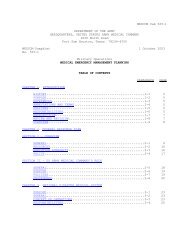(MCD) Guidelines
(MCD) Guidelines
(MCD) Guidelines
Create successful ePaper yourself
Turn your PDF publications into a flip-book with our unique Google optimized e-Paper software.
<strong>Guidelines</strong> for Military Mass Casualty Decontamination Operations<br />
During a Domestic HAZMAT/Weapon of Mass Destruction Incident<br />
HAZMAT, whether chemical, biological, or radiological, are present in all aspects of<br />
everyday life. HAZMAT incidents, either accidental or intentional, have increased in<br />
recent years. The following examples show the increasingly effective use of<br />
HAZMAT/WMDs by terrorists, both on American and foreign soil:<br />
• 1984 Salmonella release in a salad bar in Oregon (0 killed, 715 sickened) 3<br />
• 1995 sarin attack in the Tokyo subway (12 killed, 3800 injured), which was<br />
preceded by a test run in 1994 (7 killed, 500 injured) 4<br />
• 2001 anthrax-laden letters in the U.S. mail (5 killed, 17 sickened) 5<br />
• 2006 assassination of Alexander Litvinenko by polonium-210-induced acute<br />
radiation syndrome<br />
• Regularly occurring use of chlorine-laden bombs in Iraq 6<br />
Incidents in England, France, and Germany, and countless attacks contributed to Al<br />
Qaeda show that this problem does not just affect American soil. HAZMAT is<br />
available and transported in large quantities, which makes them easier to access by<br />
terrorists. Hundreds of casualties may be produced a large-scale HAZMAT or WMD<br />
incident, whether accidental or intentional. <strong>MCD</strong> is one of the key elements in<br />
consequence management planning, response operations, and recovery.<br />
<strong>MCD</strong> can take many forms and use many different techniques. Each technique can<br />
be just as effective as another in removing contamination from casualties. These<br />
<strong>Guidelines</strong> present baseline and alternate <strong>MCD</strong> operations that are based on military<br />
and civilian guidance and doctrine. However, actual <strong>MCD</strong> operations are based on<br />
available equipment, hazard, time, number of casualties, environmental conditions,<br />
and resources at the scene. <strong>MCD</strong> operations must be adaptable, innovative, and,<br />
when necessary, improvisational. 7 This document describes <strong>MCD</strong> operations that<br />
imply a combination of a large number of casualties and incident conditions that<br />
challenges or exceeds a jurisdiction’s ability to provide basic life saving services.<br />
2.0 Objective and Scope<br />
This document is designed to provide military personnel with a supplemental tool to<br />
plan and train mass decontamination operations. Specifically, these <strong>Guidelines</strong><br />
address the decontamination of an overwhelming number of people resulting from a<br />
HAZMAT/WMD incident in a populated area.<br />
Mass casualty decontamination is NOT an exact science. The diversity of chemical,<br />
biological, and radiological agents that have the capability to produce casualties that<br />
need decontamination prior to medical care is overwhelming. The lack of empirical<br />
evidence from large-scale <strong>MCD</strong> incidents requires that planning involve an<br />
appropriate <strong>MCD</strong> process that causes the least harm and does the most good for<br />
the majority of casualties. Military and civilian responders conduct <strong>MCD</strong> operations<br />
after a HAZMAT/WMD incident to save lives, minimize suffering, and prepare<br />
casualties for follow-on medical care. These <strong>Guidelines</strong> explain the theory behind<br />
suggested baseline operational techniques, but the listed and implied steps are not<br />
definitive. The actual incident and associated conditions itself dictates what specific<br />
2 Original



